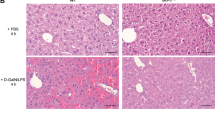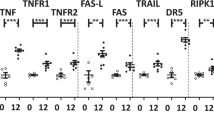Abstract
Hepatocyte apoptosis was recently described for NASH patients. The pathomechanisms are incompletely understood, but upregulation of the death receptor Fas was detectable on hepatocytes of NASH patients. We analyzed the sensitivity of fatty liver against CD95/Fas-mediated apoptotic cell death by injection of agonistic anti-Fas antibody (Jo2) in obese ob/ob mice and lean control animals. Ob/ob mice died within 12 hrs, whereas control animals survived. Liver enzymes were significantly increased compared to those in control mice (P < 0.001). Histological analysis and also TUNEL assay of liver sections from ob/ob mice exhibited massive liver injury. Activity of caspase 3 was significantly more enhanced in livers of ob/ob mice after Jo2 challenge. The increased sensitivity was confirmed in vitro by using ob/ob-derived primary hepatocytes. CD95 expression was similar in ob/ob and control mice. However, hepatocytes from ob/ob mice revealed a decreased mitochondrial membrane potential, suggesting that mitochondria play a potential role in this increased susceptibility.





Similar content being viewed by others
References
Diehl AM (1999) Nonalcoholic steatohepatitis. Semin Liver Dis 19:221–229
Tilg H (2001) Nonalcoholic steatohepatitis: Epidemiology, diagnosis and treatment. Dtsch Med Wochenschr 126:467–471
Angulo P, Keach JC, Batts KP, Lindor KD (1999) Independent predictors of liver fibrosis in patients with nonalcoholic steatohepatitis. Hepatology 30:1356–1362
Marceau P, Biron S, Hould FS, Marceau S, Simard S, Thung SN, Kral JG (1999) Liver pathology and the metabolic syndrome X in severe obesity. J Clin Endocrinol Metab 84:1513–1517
Ratziu V, Giral P, Charlotte F, Bruckert E, Thibault V, Theodorou I, Khalil L, Turpin G, Opolon P, Poynard T (2000) Liver fibrosis in overweight patients. Gastroenterology 118:1117–1123
Lee RG (1989) Nonalcoholic steatohepatitis: A study of 49 patients. Hum Pathol 20:594–598
Powell EE, Cooksley WG, Hanson R, Searle J, Halliday JW, Powell LW (1990) The natural history of nonalcoholic steatohepatitis: A follow-up study of forty-two patients for up to 21 years. Hepatology 11:74–80
Bacon BR, Farahvash MJ, Janney CG, Neuschwander-Tetri BA (1994) Nonalcoholic steatohepatitis: An expanded clinical entity. Gastroenterology 107:1103–1109
Caldwell SH, Oelsner DH, Iezzoni JC, Hespenheide EE, Battle EH, Driscoll CJ (1999) Cryptogenic cirrhosis: Clinical characterization and risk factors for underlying disease. Hepatology 29:664–669
Teli MR, James OF, Burt AD, Bennett MK, Day CP (1995) The natural history of nonalcoholic fatty liver: A follow-up study. Hepatology 22:1714–1719
Tilg H, Diehl AM (2000) Cytokines in alcoholic and nonalcoholic steatohepatitis. N Engl J Med 343:1467–1476
Chitturi S, Farrell GC (2001) Etiopathogenesis of nonalcoholic steatohepatitis. Semin Liver Dis 21:27–41
Friedman JM, Leibel RL, Siegel DS, Walsh J, Bahary N (1991) Molecular mapping of the mouse ob mutation. Genomics 11:1054–1062
Andersson LB (1996) Genes and obesity. Ann Med 28:5–7
Yang SQ, Lin HZ, Lane MD, Clemens M, Diehl AM (1997) Obesity increases sensitivity to endotoxin liver injury: Implications for the pathogenesis of steatohepatitis. Proc Natl Acad Sci USA 94:2557–2562
Faggioni R, Fantuzzi G, Gabay C, Moser A, Dinarello CA, Feingold KR, Grunfeld C (1999) Leptin deficiency enhances sensitivity to endotoxin-induced lethality. Am J Physiol 276:R136–R142
Takahashi N, Waelput W, Guisez Y (1999) Leptin is an endogenous protective protein against the toxicity exerted by tumor necrosis factor. J Exp Med 189:207–212
Guebre-Xabier M, Yang S, Lin HZ, Schwenk R, Krzych U, Diehl AM (2000) Altered hepatic lymphocyte subpopulations in obesity-related murine fatty livers: Potential mechanism for sensitization to liver damage. Hepatology 31:633–640
Tiegs G, Hentschel J, Wendel A (1992) A T cell-dependent experimental liver injury in mice inducible by concanavalin A. J Clin Invest 90:196–203
Gantner F, Leist M, Lohse AW, Germann PG, Tiegs G (1995) Concanavalin A-induced T-cell-mediated hepatic injury in mice: The role of tumor necrosis factor. Hepatology 21:190–198
Siebler J, Wirtz S, Klein S, Protschka M, Blessing M, Galle PR, Neurath MF (2003) A key pathogenic role for the STAT1/T-bet signaling pathway in T-cell-mediated liver inflammation. Hepatology 38:1573–1580
Faggioni R, Jones-Carson J, Reed DA, Dinarello CA, Feingold KR, Grunfeld C, Fantuzzi G (2000) Leptin-deficient (ob/ob) mice are protected from T cell-mediated hepatotoxicity: Role of tumor necrosis factor alpha and IL-18. Proc Natl Acad Sci USA 97:2367–2372
Patel T, Roberts LR, Jones BA, Gores GJ (1998) Dysregulation of apoptosis as a mechanism of liver disease: An overview. Semin Liver Dis 18:105–114
Schuchmann M, Galle PR (2001) Apoptosis in liver disease. Eur J Gastroenterol Hepatol 13:785–790
Feldstein AE, Canbay A, Angulo P, Taniai M, Burgart LJ, Lindor KD, Gores GJ (2003) Hepatocyte apoptosis and fas expression are prominent features of human nonalcoholic steatohepatitis. Gastroenterology 125:437–443
Feldstein AE, Canbay A, Guicciardi ME, Higuchi H, Bronk SF, Gores GJ (2003) Diet associated hepatic steatosis sensitizes to Fas mediated liver injury in mice. J Hepatol 39:978–983
Ogasawara J, Watanabe-Fukunaga R, Adachi M, Matsuzawa A, Kasugai T, Kitamura Y, Itoh N, Suda T, Nagata S (1993) Lethal effect of the anti-Fas antibody in mice. Nature 364:806–809
Schuchmann M, Varfolomeev EE, Hermann F, Rueckert F, Strand D, Koehler H, Strand S, Lohse AW, Wallach D, Galle PR (2003) Dominant negative MORT1/FADD rescues mice from CD95 and TNF-induced liver failure. Hepatology 37:129–135
Rashid A, Wu TC, Huang CC, Chen CH, Lin HZ, Yang SQ, Lee FY, Diehl AM (1999) Mitochondrial proteins that regulate apoptosis and necrosis are induced in mouse fatty liver. Hepatology 29:1131–1138
Skulachev VP (1996) Why are mitochondria involved in apoptosis? Permeability transition pores and apoptosis as selective mechanisms to eliminate superoxide-producing mitochondria and cell. FEBS Lett 397:7–10
Ravagnan L, Roumier T, Kroemer G (2002) Mitochondria, the killer organelles and their weapons. J Cell Physiol 192:131–137
Lin HZ, Yang SQ, Chuckaree C, Kuhajda F, Ronnet G, Diehl AM (2000) Metformin reverses fatty liver disease in obese, leptin-deficient mice. Nat Med 6:998–1003
Yang SQ, Lin HZ, Mandal AK, Huang J, Diehl AM (2001) Disrupted signaling and inhibited regeneration in obese mice with fatty livers: Implications for nonalcoholic fatty liver disease pathophysiology. Hepatology 34:694–706
Latta M, Kunstle G, Leist M, Wendel A (2000) Metabolic depletion of ATP by fructose inversely controls CD95- and tumor necrosis factor receptor 1-mediated hepatic apoptosis. J Exp Med 191:1975–1985
Baffy G, Zhang CY, Glickman JN, Lowell BB (2002) Obesity-related fatty liver is unchanged in mice deficient for mitochondrial uncoupling protein 2. Hepatology 35:753–761
Acknowledgments
We thank Sonja Klein for excellent technical assistance and Prof. A. Wendel and Dr. M. Latta, Department of Biochemical Pharmacology, University of Konstanz, Konstanz, Germany, for critical and helpful discussions.
Author information
Authors and Affiliations
Corresponding author
Additional information
Juergen Siebler and Markus Schuchmann contributed equally to the work.
Rights and permissions
About this article
Cite this article
Siebler, J., Schuchmann, M., Strand, S. et al. Enhanced Sensitivity to CD95-Induced Apoptosis in ob/ob Mice. Dig Dis Sci 52, 2396–2402 (2007). https://doi.org/10.1007/s10620-006-9148-7
Received:
Accepted:
Published:
Issue Date:
DOI: https://doi.org/10.1007/s10620-006-9148-7




